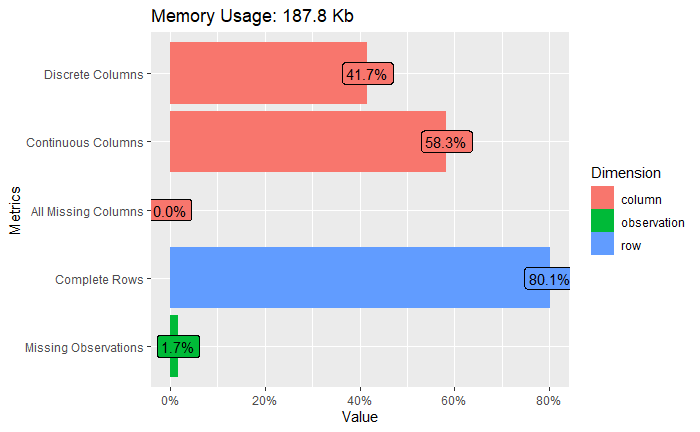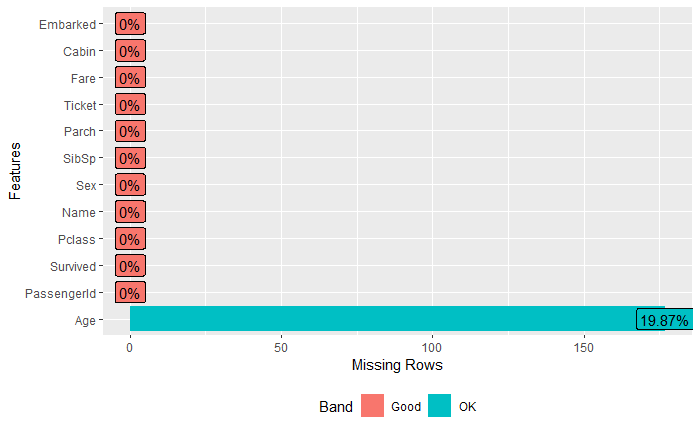Dealing with missing data : Mean imputation (Using R)
- sam33frodon
- Dec 28, 2020
- 7 min read
Updated: Jan 27, 2021
library(tidyverse)library(DataExplorer)
library(dplyr)A. Detecting missing values
data <- read.csv(file = "https://raw.githubusercontent.com/agconti/kaggle-titanic/master/data/train.csv", header = T, sep = ",")str(data)## 'data.frame': 891 obs. of 12 variables:
## $ PassengerId: int 1 2 3 4 5 6 7 8 9 10 ...
## $ Survived : int 0 1 1 1 0 0 0 0 1 1 ...
## $ Pclass : int 3 1 3 1 3 3 1 3 3 2 ...
## $ Name : Factor w/ 891 levels "Abbing, Mr. Anthony",..: 109 191 358 277 16 559 520 629 417 581 ...
## $ Sex : Factor w/ 2 levels "female","male": 2 1 1 1 2 2 2 2 1 1 ...
## $ Age : num 22 38 26 35 35 NA 54 2 27 14 ...
## $ SibSp : int 1 1 0 1 0 0 0 3 0 1 ...
## $ Parch : int 0 0 0 0 0 0 0 1 2 0 ...
## $ Ticket : Factor w/ 681 levels "110152","110413",..: 524 597 670 50 473 276 86 396 345 133 ...
## $ Fare : num 7.25 71.28 7.92 53.1 8.05 ...
## $ Cabin : Factor w/ 148 levels "","A10","A14",..: 1 83 1 57 1 1 131 1 1 1 ...
## $ Embarked : Factor w/ 4 levels "","C","Q","S": 4 2 4 4 4 3 4 4 4 2 ...The data contain 891 observations and 12 variables.
Interger and numeric type : PassengerId, Survived, Pclass, Age, SibSp, Parch.
Fare Factor type: Name, Sex, Ticket, Cabin, Embarked.
Description of the data set
PassengerID: Id of passengers Survived: (0 = No; 1 = Yes)
Pclass: Passenger Class (1 = 1st; 2 = 2nd; 3 = 3rd)
Name: Name
Sex: Genders of passengers
Age: Age
Sibsp: Number of Siblings/Spouses
Aboard Parch: Number of Parents/Children Aboard
Ticket: Ticket Number
Fare: Passenger Fare (British pound)
Cabin: Cabin Embarked: Port of Embarkation (C = Cherbourg; Q = Queenstown; S = Southampton)
We can also plot the summary above using plot_intro function.
plot_intro(data)
There are 5 discrete columns and 7 continuous columns, corresponding to the 5 columns of factor type and to the 7 columns of numeric and integer type, respectively.
There are 177 missing values and 714 completed rows.
There are 10692 observations = 891 rows * 12 variables = 10692 There is 1.7% missing observations (177/10692 = 1.655%) complete rows :80.1% (714/891 = 80.13 %)
If we want to know which column containing missing values
plot_missing(data)
All the missing values are found in the column age. In fact, 19.87 % of data in this column is missing. There are 892 rows. There are 19.87% * 891 = 177 missing rows, in agreement with the summary above.
Other way to check that number
sum(is.na(data$Age))## [1] 177If we want to see missing values for each column
sapply(data,function(x)sum(is.na(x)))## PassengerId Survived Pclass Name Sex Age
## 0 0 0 0 0 177
## SibSp Parch Ticket Fare Cabin Embarked
## 0 0 0 0 0 0data %>%
sapply(function(x) sum(is.na(x)))## PassengerId Survived Pclass Name Sex Age
## 0 0 0 0 0 177
## SibSp Parch Ticket Fare Cabin Embarked
## 0 0 0 0 0 0B. Imputation using mean
One way to deal with missing values is to replace NA rows by the mean value of the column. In this data set, we only have missing values for the age column. One way to deal with this situation is to replace the missing value by the average age. As the title may be related to the age, we will calculate the average age for each group of people who have the same title. As we have many titles (Mr, Ms, etc…) = many genders, we would assign the average age in function of title. We should know how many titles in this data set what are theses titles ? what are the average age of each of these groups ?
First, we will create a new column that contains only the title. Adding a column title into a data set
How does the name column look like ?
data %>%
select(Name) %>%
head(10)## Name
## 1 Braund, Mr. Owen Harris
## 2 Cumings, Mrs. John Bradley (Florence Briggs Thayer)
## 3 Heikkinen, Miss. Laina
## 4 Futrelle, Mrs. Jacques Heath (Lily May Peel)
## 5 Allen, Mr. William Henry
## 6 Moran, Mr. James
## 7 McCarthy, Mr. Timothy J
## 8 Palsson, Master. Gosta Leonard
## 9 Johnson, Mrs. Oscar W (Elisabeth Vilhelmina Berg)
## 10 Nasser, Mrs. Nicholas (Adele Achem)You can see that the title is included in the name. We should remove the title and create a new column containing only the title
data <- data %>%
mutate(Title = regmatches(Name, regexpr("[A-z]+\\.", Name)))data %>%
select(Name, Title) %>%
head(10)## Name Title
## 1 Braund, Mr. Owen Harris Mr.
## 2 Cumings, Mrs. John Bradley (Florence Briggs Thayer) Mrs.
## 3 Heikkinen, Miss. Laina Miss.
## 4 Futrelle, Mrs. Jacques Heath (Lily May Peel) Mrs.
## 5 Allen, Mr. William Henry Mr.
## 6 Moran, Mr. James Mr.
## 7 McCarthy, Mr. Timothy J Mr.
## 8 Palsson, Master. Gosta Leonard Master.
## 9 Johnson, Mrs. Oscar W (Elisabeth Vilhelmina Berg) Mrs.
## 10 Nasser, Mrs. Nicholas (Adele Achem) Mrs.To remove titles in the column name
data <- data %>%
mutate(Name = gsub("[A-z]+\\.","",Name))To check if titles were removed
data %>%
select(Name, Title) %>%
head(10)## Name Title
## 1 Braund, Owen Harris Mr.
## 2 Cumings, John Bradley (Florence Briggs Thayer) Mrs.
## 3 Heikkinen, Laina Miss.
## 4 Futrelle, Jacques Heath (Lily May Peel) Mrs.
## 5 Allen, William Henry Mr.
## 6 Moran, James Mr.
## 7 McCarthy, Timothy J Mr.
## 8 Palsson, Gosta Leonard Master.
## 9 Johnson, Oscar W (Elisabeth Vilhelmina Berg) Mrs.
## 10 Nasser, Nicholas (Adele Achem) Mrs.Now, we place the column title in after the column name
data <- data %>%
select(PassengerId, Name, Title, Sex, Age, everything())head(data, 10)## PassengerId Name Title Sex
## 1 1 Braund, Owen Harris Mr. male
## 2 2 Cumings, John Bradley (Florence Briggs Thayer) Mrs. female
## 3 3 Heikkinen, Laina Miss. female
## 4 4 Futrelle, Jacques Heath (Lily May Peel) Mrs. female
## 5 5 Allen, William Henry Mr. male
## 6 6 Moran, James Mr. male
## 7 7 McCarthy, Timothy J Mr. male
## 8 8 Palsson, Gosta Leonard Master. male
## 9 9 Johnson, Oscar W (Elisabeth Vilhelmina Berg) Mrs. female
## 10 10 Nasser, Nicholas (Adele Achem) Mrs. female
## Age Survived Pclass SibSp Parch Ticket Fare Cabin Embarked
## 1 22 0 3 1 0 A/5 21171 7.2500 S
## 2 38 1 1 1 0 PC 17599 71.2833 C85 C
## 3 26 1 3 0 0 STON/O2. 3101282 7.9250 S
## 4 35 1 1 1 0 113803 53.1000 C123 S
## 5 35 0 3 0 0 373450 8.0500 S
## 6 NA 0 3 0 0 330877 8.4583 Q
## 7 54 0 1 0 0 17463 51.8625 E46 S
## 8 2 0 3 3 1 349909 21.0750 S
## 9 27 1 3 0 2 347742 11.1333 S
## 10 14 1 2 1 0 237736 30.0708 CCounting the title and order the output
data %>%
group_by (Title) %>%
count(sort = TRUE)## # A tibble: 17 x 2
## # Groups: Title [17]
## Title n
## <chr> <int>
## 1 Mr. 517
## 2 Miss. 182
## 3 Mrs. 125
## 4 Master. 40
## 5 Dr. 7
## 6 Rev. 6
## 7 Col. 2
## 8 Major. 2
## 9 Mlle. 2
## 10 Capt. 1
## 11 Countess. 1
## 12 Don. 1
## 13 Jonkheer. 1
## 14 Lady. 1
## 15 Mme. 1
## 16 Ms. 1
## 17 Sir. 1There are 17 groups. Mr., Miss., Mrs. are the most common among titles. There are some uncommon titles such as: Capt., Countess., Don., Jonkheer., Lady., Mme., Ms., and Sir.
Checking the number of missing rows by title
data %>%
group_by(Title) %>%
summarise(missing_total = sum(is.na(Age))) %>%
arrange(desc(missing_total))## # A tibble: 17 x 2
## Title missing_total
## <chr> <int>
## 1 Mr. 119
## 2 Miss. 36
## 3 Mrs. 17
## 4 Master. 4
## 5 Dr. 1
## 6 Capt. 0
## 7 Col. 0
## 8 Countess. 0
## 9 Don. 0
## 10 Jonkheer. 0
## 11 Lady. 0
## 12 Major. 0
## 13 Mlle. 0
## 14 Mme. 0
## 15 Ms. 0
## 16 Rev. 0
## 17 Sir. 0The missing values were found at corresponding rows : 119 for Mr., 36 for Miss., 17 for Mrs., 4 for Master., and 1 for Dr. Because there are only 5 groups that contain missing values. We will calculate the mean age of these 5 groups rather than 17 groups
data %>%
filter(Title %in% c("Mr.","Miss.", "Mrs.", "Master.","Dr.")) %>%
group_by(Title) %>%
summarise (average = mean(Age, na.rm = TRUE))## # A tibble: 5 x 2
## Title average
## <chr> <dbl>
## 1 Dr. 42
## 2 Master. 4.57
## 3 Miss. 21.8
## 4 Mr. 32.4
## 5 Mrs. 35.9Miss., 182 rows, the average age = 21.77 Mr., 517 rows, the average age = 32.36 Mrs.,125 rows, the average age= 35.89 Master., 40 rows, the average age = 4.57
Assign the missing values of the age column by respectable values Now, we can replace missing values by the mean of corresponding groups
data <- data %>%
mutate(Age = case_when(Title == "Mr." & is.na(Age) ~ mean(Age[Title == "Mr."], na.rm = TRUE),
Title == "Miss." & is.na(Age)~ mean(Age[Title == "Miss."], na.rm = TRUE),
Title == "Mrs." & is.na(Age) ~ mean(Age[Title == "Mrs."], na.rm = TRUE),
Title == "Master." & is.na(Age) ~ mean(Age[Title == "Master."], na.rm = TRUE),
Title == "Dr." & is.na(Age) ~ mean(Age[Title == "Dr."], na.rm = TRUE),
TRUE ~ Age))sum(is.na(data$Age))## [1] 0Other way to replace missing value.
train$Age[train$Title == "Mr." & is.na(train$Age)] <- mean(train$Age[train$Title == "Mr."], na.rm = TRUE)train$Age[train$Title == "Miss." & is.na(train$Age)] <- mean(train$Age[train$Title == "Miss."], na.rm = TRUE)train$Age[train$Title == "Mrs." & is.na(train$Age)] <- mean(train$Age[train$Title == "Mrs."], na.rm = TRUE)train$Age[train$Title == "Master." & is.na(train$Age)] <- mean(train$Age[train$Title == "Master."], na.rm = TRUE)





Comments